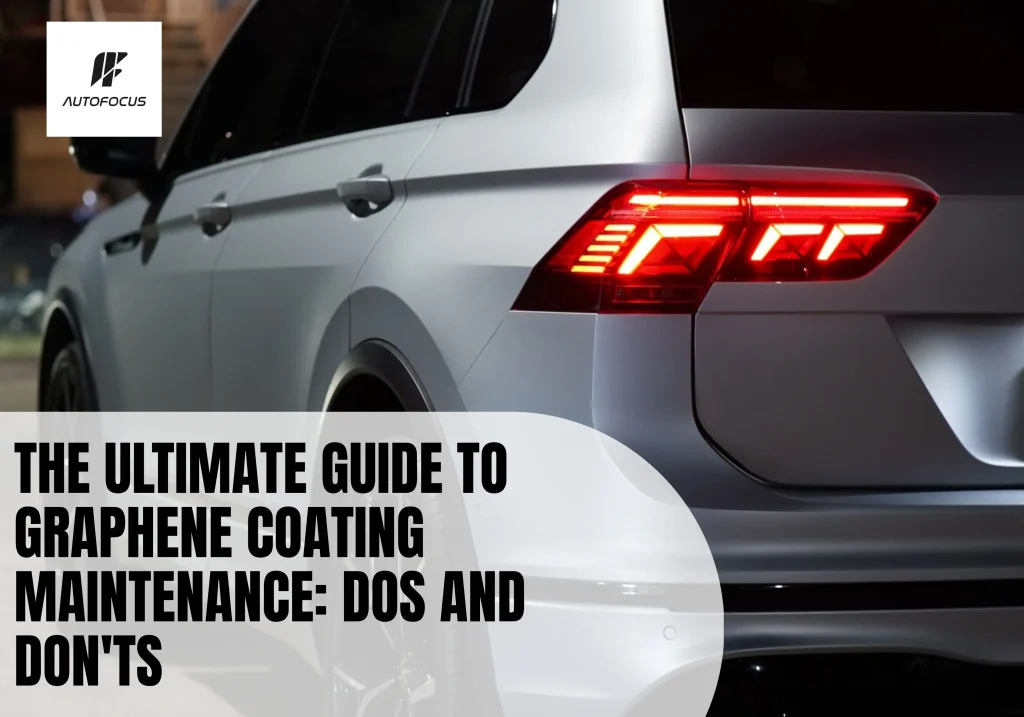
You’ve invested in premium graphene coating for your vehicle, but here’s the uncomfortable truth: most owners unknowingly destroy their protection within the first year. The culprit? Slapping traditional wax techniques onto graphene technology is like using a flip phone manual to set up a smartphone—they’re built on entirely different science.
But here’s what most people miss: using old-school wash methods on graphene coatings doesn’t just waste your investment—it actively undermines the molecular advantages that make this technology so effective. This guide reveals exactly what works—and what silently sabotages your investment—so you can maximise your coating’s performance for years to come.
Your Graphene Coating Is Already Degrading—The Scientific Truth No One Told You
Understanding the Science Behind Your Vehicle’s Shield
Your graphene coating operates on principles completely different from traditional sealants. Graphene-based composite coatings provide superior protection thanks to their unique molecular architecture. What makes them special is how the modified graphene oxide distributes throughout the coating, creating what researchers describe as “extra torturous paths”—essentially forming a maze that forces corrosive substances to navigate before they can ever reach your paintwork.
This exceptional barrier property comes from graphene’s unique structure. Graphene’s impermeable structure and high surface area create an exceptional barrier against water, oxygen, and corrosive compounds—far surpassing traditional waxes in both chemical and thermal stability. That’s exactly why the aerospace and automotive industries are rapidly adopting this technology.
Why Graphene Requires a Unique Maintenance Approach
Most conventional car care products are loaded with abrasives, silicones, and fillers that directly clash with how graphene works at a molecular level. The moment you layer traditional wax on top, you’re actually suffocating the coating and blocking its ability to do what it was designed for. Graphene coating maintenance demands a more intelligent approach because you’re maintaining high-tech protection, not just shiny paint.
Stop Washing Your Car Like It's 2015—Here's What Actually Works
DO Use pH-Neutral Washing Solutions
Your coating thrives in a neutral pH environment, so harsh cleaners—whether acidic or alkaline—will gradually break down its protective barrier. Stick with pH-balanced shampoos made specifically for graphene or ceramic coatings.
DO Follow the Two-Bucket Method
This method prevents dirt particles from being dragged across your coating:
- Fill one bucket with pH-neutral wash solution and clean water
- Fill the second bucket with clean water only for rinsing your mitt
- Wash one panel, then thoroughly rinse the mitt in the clean water bucket before reloading with soap
- This prevents contaminants from causing microscratching over time
DO Use High-Quality Microfibre Materials
Use microfibre towels with a GSM rating of at least 350. Higher GSM means more absorbency and a plusher surface that won’t create friction damage on your smooth graphene coating.
Lorem ipsum dolor sit amet, consectetur adipiscing elit. Ut elit tellus, luctus nec ullamcorper mattis, pulvinar dapibus leo.
The Graphene Coating Maintenance Mistakes—Avoid These or Watch Your Protection Vanish
DON’T Use Automatic Car Washes
Spinning brushes drag contaminants from hundreds of vehicles across your premium surface. The harsh alkaline chemicals are far too aggressive for maintaining your coating’s integrity.
DON’T Apply Wax or Traditional Sealants
Traditional waxes create an interference layer that blocks your coating’s hydrophobic properties. Your coating actually performs worse, not better.
DON’T Use Harsh Chemical Cleaners
Scientific testing reveals exactly what happens when aggressive chemicals attack graphene at the molecular level. Research using Raman spectroscopy shows measurable degradation when graphene coatings face harsh chemical exposure. In controlled testing, coatings exposed to corrosive environments showed structural changes—with ID/IG ratio shifts from 0.92 to 0.71—which indicates that the graphene’s protective structures begin to oxidise and break down.
Avoid cleaners containing ammonium hydroxide (found in glass cleaners), sodium hydroxide (in degreasers), strong acidic compounds (in wheel cleaners), and petroleum distillates. The reason is simple: these don’t just clean—they chemically interact with your coating’s structure, gradually weakening the protective barriers over time.
DON’T Neglect Immediate Contaminant Removal
Bird droppings, tree sap, and bug splatter contain acidic compounds that etch into your coating if left untreated. In Sydney’s heat, bird dropping acid intensifies and can bond permanently within hours. That’s why it’s smart to keep a quick detailer spray and microfibre cloth handy for emergency spot cleaning.
DON’T Skip Pre-Wash Preparation
Before you even grab your wash mitt, rinse off all the loose grit that could turn into sandpaper against your coating. Even better? Hit it with a pre-wash foam first—this loosens up stubborn contaminants so they slide right off without you having to scrub.
DO Wash in Sydney’s Cooler Hours
It’s a fact that Sydney’s intense UV exposure creates these myriad of challenges. Never wash in direct sunlight—heat makes water evaporate before you can rinse it off, leaving mineral deposits that literally bake onto your coating. Stick to early morning or late afternoon when the sun’s not blazing.
DO Dry with Proper Technique
You can do blow-drying. Use a car dryer to remove water without physical contact—this is the safest method. If you’d rather go hands-on, the patting method works brilliantly—just take a high-quality microfibre towel and blot the surface gently instead of wiping it around.
DO Schedule Professional Inspections
Specialists can detect early degradation invisible to the untrained eye and perform maintenance treatments that restore hydrophobic properties. Working with professionals helps maximise your vehicle’s protection without costly DIY mistakes.
The Fool-Proof Defence Plan to Protect Your Coating Against Sydney's Climate
Seasonal Considerations You Should Know About
Sydney’s relentless summer sun pounds your vehicle with UV radiation, but graphene’s thermal stability is built for exactly this kind of punishment. Just remember to wash more often during these hotter months—you’ll need to tackle that coastal salt spray and keep water spots from setting in. Coastal residents face year-round salt air exposure, which graphene’s exceptional barrier properties significantly slow.
How Often Should You Wash Your Graphene-Coated Vehicle?
- Daily urban drivers: Every two weeks minimum
- Coastal residents: Weekly to combat salt air
- Garaged vehicles: Every three to four weeks
- Near construction/industrial areas: Weekly or bi-weekly
The Science Behind Graphene’s Durability
Real-world testing proves why proper graphene coating maintenance delivers exceptional results. Four-month aging tests revealed something impressive: graphene coatings barely degraded at all. Contact angles stayed locked between 44° and 47°, which means the water-repelling performance remained rock-solid throughout the entire period.
In lab tests, an hour of continuous water spray barely touched the coating’s structure. What’s more impressive is the mechanical strength—graphene showed 1.8 times higher Young’s modulus than bare paint, meaning it can take far more impact and stress before breaking down. And when tested for adhesion under ISO 2409 standards, it scored a Class 1 rating (that’s excellent, by the way), proving the coating won’t peel or lift even when hammered by the elements.
Most Owners Miss These Warning Signs Your Graphene Coating Is Dying
Visual Indicators of Coating Degradation
Watch for reduced water beading, dull or flat spots lacking deep gloss, increased water spotting, rough texture when touched, and visible staining from contaminants. These signs indicate your coating’s protective barrier is weakening.
Your Current DIY Maintenance Isn’t Enough
Seeing several of these signs at once? That’s when you need expert eyes on your coating. A specialist can run a proper decontamination treatment and tell you whether a maintenance boost will do the trick or if you’re looking at a full reapplication. Attempting aggressive correction yourself often causes more harm than good.

Why Professional Graphene Coating Maintenance Makes the Difference
At Autofocus Solutions, we combine advanced application techniques with premium brands including STEK, Suntek, and Gtechniq to deliver exceptional results. Our meticulous attention to detail ensures every surface receives optimal protection tailored to Sydney’s environmental challenges.
We’re committed to long-term relationships with our clients, ensuring your vehicle maintains showroom condition for years. Whether you’re considering your first graphene coating or your existing protection needs assessment, you can book a no-obligation consultation and get that much-needed recommended solutions for your situation.
Your vehicle deserves the best protection available. Discover how Autofocus Solutions can help you maintain pristine condition today.